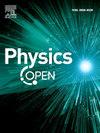A comparative artificial neural networks for Schwarzschild black hole (SBH) radius
IF 1.4
Q2 Physics and Astronomy
引用次数: 0
Abstract
It is consensus among researchers that the data for the black holes is complicated and extremely non-linear in nature. Therefore, it remains a challenging task for them to predict the key characteristics of concerned black holes accurately. The present work offers artificial neural networks assistance in the context of a choice of training functions for the prediction of astrophysical phenomena like the event horizon and radius of black holes. To be more specific, we considered the Schwarzschild black hole as the simplest solution of Einstein's field equations. The Schwarzschild radius and masses are chosen in the last and first layers of the neural networks model, respectively. Two various training functions namely Levenberg-Marquardt training algorithm (LMTA) and Scaled Conjugate Gradient training algorithms (SCGTA) are used. We have observed that the LMTA achieved significantly lower error rates, suggesting a better fit and stronger learning capabilities from the solar masses of black holes. Furthermore, the close alignment between the ANN-predicted and actual Schwarzschild black hole radius demonstrates the LMTA model holds the ability to generalize effectively across unseen masses of black holes.
史瓦西黑洞(SBH)半径的比较人工神经网络
研究人员一致认为,黑洞的数据是复杂的,本质上是极其非线性的。因此,准确预测相关黑洞的关键特征仍然是一项具有挑战性的任务。目前的工作提供了人工神经网络在选择训练函数的背景下帮助预测天体物理现象,如事件视界和黑洞半径。更具体地说,我们认为史瓦西黑洞是爱因斯坦场方程的最简单解。在神经网络模型的最后一层和第一层分别选择史瓦西半径和质量。使用了两种不同的训练函数,即Levenberg-Marquardt训练算法(LMTA)和缩放共轭梯度训练算法(SCGTA)。我们观察到LMTA的错误率明显更低,这表明它具有更好的拟合和更强的学习能力,可以从黑洞的太阳质量中学习。此外,人工神经网络预测的黑洞半径与实际的史瓦西黑洞半径之间的紧密一致表明,LMTA模型具有有效推广到看不见的黑洞质量的能力。
本文章由计算机程序翻译,如有差异,请以英文原文为准。
求助全文
约1分钟内获得全文
求助全文
来源期刊

Physics Open
Physics and Astronomy-Physics and Astronomy (all)
CiteScore
3.20
自引率
0.00%
发文量
19
审稿时长
9 weeks
 求助内容:
求助内容: 应助结果提醒方式:
应助结果提醒方式:


